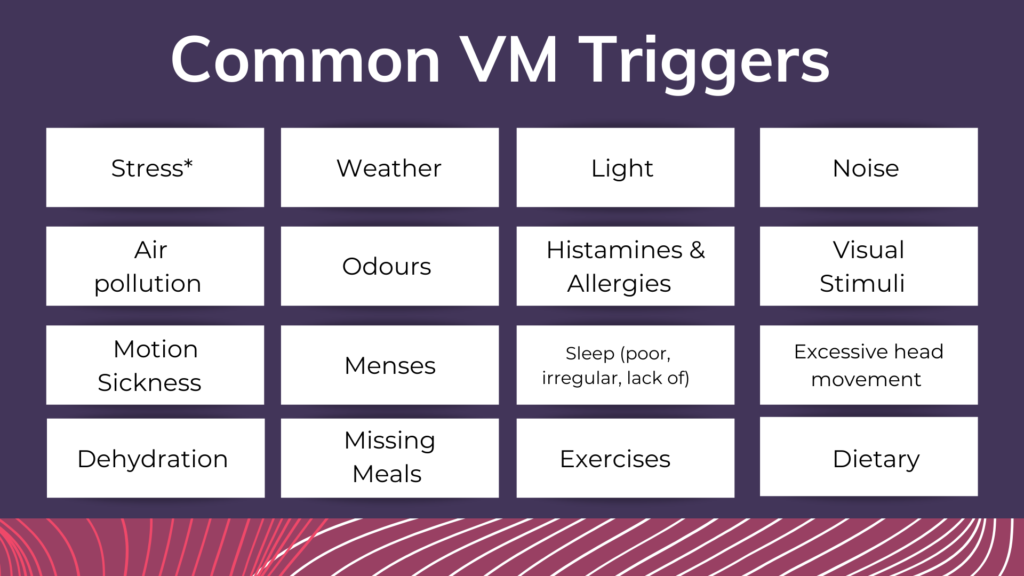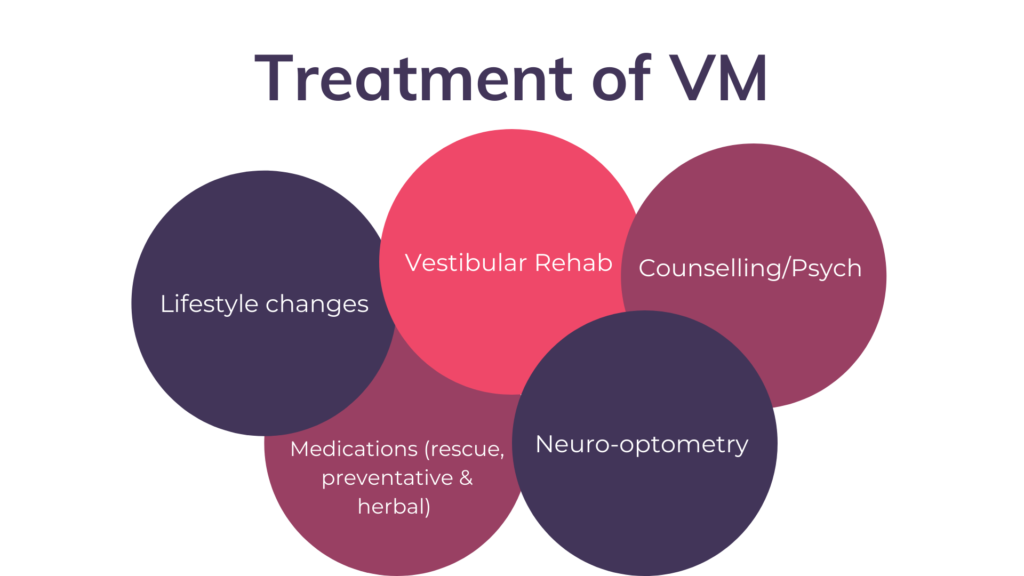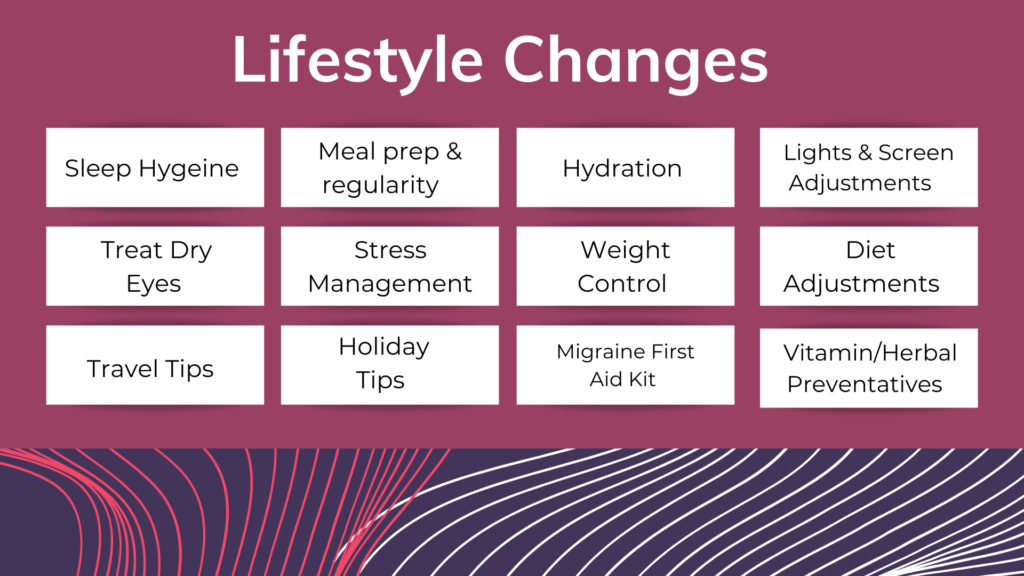What is Vestibular Migraine (VM)?
VM is a type of migraine that mainly manifests with VERTIGO & DIZZINESS
- Headaches MAY happen with VM, but are not the most significant part
- Vertigo & dizziness are the main & most disabling symptoms of the disorder
- Most suggestive feature is VISUAL VERTIGO (vertigo worse with any visual stimuli e.g. scrolling patterns, moving objects and movement of large crowds)
Vestibular Migraine is NOT just migraine + vertigo & dizziness!
Vestibular Migraine Facts:
- Most common NEUROLOGICAL cause of vertigo in adults
- Under-recognized & Under-diagnosed
- Affects approx. 3% of adult population (approx. 10 million Americans)
- Found to be the most common cause of episodic dizziness in adults
- Seems to be a relationship with hormonal changes
- Often VM sufferers have had migraines in their early life
- After menopause headaches improve (or disappear)
- BUT then vertigo & dizziness comes in later
How long can a VM episode last?
A VM episode can last from seconds, minutes, hours to days. This varies person to person. The core episode of VM rarely lasts >72 hours.
***However, it may take up to 4 weeks to fully recover from an episode. This means that you can still have some symptoms after the attack. This may include: headache, dizziness, nausea, motion sensitivity, neck pain.
ONLY 1 SYMPTOM is required for it to be a VM episode. Also different symptoms can occur during different episodes, this means that no 1 VM attack looks the same!
What Triggers a VM episode?

Why is it important to identify VM triggers?
✓ Helps you get control of your VM
✓ You can take steps to reduce exposure to them

The best treatment approach is multidisciplinary!

Vestibular Rehabilitation Therapy (VRT) is one piece of the puzzle to help manage VM!
Vestibular Migraine & Vestibular Rehabilitation Therapy (VRT)
VRT is a specialized form of exercise based physiotherapy.
Goals of VRT:
- Reduce gaze instability
- Reduce vertigo & dizziness
- Reduce imbalance and falls risks
- Treat secondary issues after vestibular disorder
- (e.g. neck pain/stiffness with vestibular migraines or visual motion sensitivity aka car sickness, imbalance, de-conditioning)

At B3, we offer VRT with our trained vestibular therapists to help you get control and manage your VM!
A trained vestibular therapist can help you find the right vestibular rehabilitation treatment & lifestyle changes to help you manage your vestibular migraines and get back to the things you LOVE & NEED to do!
Summary:
- Vestibular Migraine is a type of migraine with vertigo & dizziness
- It is the MOST common neurological cause of vertigo in adults
- Treatment for VM is multidisciplinary
- At B3, we offer the VRT piece of the puzzle & we can refer you to other fantastic providers as needed!
- VM can be effectively managed with the right treatment for YOU
**Disclaimer: This blog post is intended for educational purposes ONLY. Information presented or discussed is not intended to assist in diagnosis or treatment of any medical condition(s). Information provided does NOT replace the advice of a knowledgeable health care provider. If you use any of the information for the purposes listed above, you do so at your own risk.
Resources:
- Alghadir, A. H., & Anwer, S. (2018). Effects of vestibular rehabilitation in the management of a vestibular migraine: A Review. Frontiers in Neurology, 9. https://doi.org/10.3389/fneur.2018.00440
- Beh, S. C. (2021). Victory over Vestibular Migraine: The action plan for healing & getting your life back. Shin C. Beh.
- Byun, Y. J., Levy, D. A., Nguyen, S. A., Brennan, E., & Rizk, H. G. (2020). Treatment of vestibular migraine: A systematic review and meta‐analysis. The Laryngoscope, 131(1), 186–194. https://doi.org/10.1002/lary.28546
- Han, B. I., Song, H. S., & Kim, J. S. (2011). Vestibular rehabilitation therapy: Review of indications, mechanisms, and key exercises. Journal of Clinical Neurology, 7(4), 184. https://doi.org/10.3988/jcn.2011.7.4.184
- Huang, T.-C., Wang, S.-J., & Kheradmand, A. (2019). Vestibular Migraine: An update on current understanding and future directions. Cephalalgia, 40(1), 107–121. https://doi.org/10.1177/0333102419869317
- Kramer , J. (2020). Vestibular migraine – veda202. vestibular.org . Retrieved January 8, 2022, from https://vestibular.org/wp-content/uploads/2012/03/Vestibular-Migraine_75.pdf
- Nowaczewska, M. (2020). Vestibular migraine — an underdiagnosed cause of vertigo. diagnosis and treatment. Neurologia i Neurochirurgia Polska. https://doi.org/10.5603/pjnns.a2020.0031
- Qi, X., Shen, Y., & Wan, T. (2020). The treatment of Vestibular Migraine: A narrative review. Annals of Indian Academy of Neurology. https://doi.org/10.4103/aian.aian_591_19
- Stolte, B., Holle, D., Naegel, S., Diener, H.-C., & Obermann, M. (2014). Vestibular migraine. Cephalalgia, 35(3), 262–270. https://doi.org/10.1177/0333102414535113
